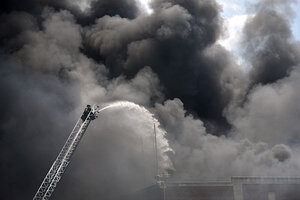Why firefighter deaths have hit historic lows
Fewer than 65 on-duty firefighters died in 2012, almost one-third fewer than three decades ago, when record keeping began.

Firefighters spray water on a large fire Saturday in Indianapolis. An estimated 150 firefighters were battling the blaze Saturday afternoon in the building about one mile southwest of the city's downtown.
Matt Detrich/The Indianapolis Star/AP
Boston
When Ken Willette started firefighting 35 years ago, his uniform left much to be desired. Little more than a raincoat with rubber boots and plastic gloves, the outfit was more likely to melt than sustain his job responsibilities.
Now, with improvements to firefighting equipment, as well as better safety standards, and a decrease in overall fires, the number of firefighter deaths has dropped by more than a third in the past three decades and has fallen to historic lows the past two years.
A total of 64 on-duty firefighters died in the US in 2012, marking the second consecutive year that the total has been below 65 deaths, the lowest level since statistics began to be tracked in 1977. The number of fatalities that occurred during actual firefighting also dropped to a record low.
It’s a significant improvement from the late 1970s, when the average number of on-duty firefighter deaths reached 151. The numbers have been trending downward since then, according to a new report by the National Fire Protection Association (NFPA). By the 1990s, the average number of on-duty deaths fell to 97 and the first decade of the 21st century saw the figure drop to 88. In the past five years the number fell further to 77 average annual fatalities.
The US Fire Administration records slightly higher statistics due to a broader definition that includes some deaths more than 24 hours after duty. Firefighters killed fighting wildfires are included in the NFPA report, but account for a small number of annual deaths.
“On one hand, the number of firefighter fatalities is decreasing in part because the number of fires are decreasing. That’s a very good thing,” says Denise Smith, a research scientist at the University of Illinois Fire Service Institute and professor at Skidmore College. Ms. Smith credits the reduction in fires to more fire alarms, sprinklers, and better building codes.
The NFPA reports that the number of residential fires dropped from about 723,000 in 1977 to 370,000 in 2011.
Yet the sharp decrease in the number of line-of-duty firefighter deaths is disproportionate to the number of fires, Smith says, meaning there are other causes at work. Smith and others credit the fire industry with making a concerted effort to address on-duty deaths during the past decade. In 2002, the US Fire Administration set a goal of reducing the number of line-of-duty deaths by 50 percent during the next decade. Industry groups like the National Fallen Firefighters Foundation and National Volunteer Fire Council started programs in support of the goal.
In 2004, the National Fallen Firefighters Foundation gathered the major industry associations for a life safety summit that resulted in the “Everyone Goes Home” program. It created 16 initiatives to reduce firefighter deaths, which were widely adopted by fire departments across the country. In 2006 they started a seat belt pledge to address the high number of firefighters who died in vehicle crashes while on-duty.
Industry analysts also point to a decade-long emphasis on reducing firefighter heart attacks as a significant factor in the decline. Sudden cardiac arrest has consistently been the leading cause of death for on-duty firefighters. But in the past decade, industry groups have started awareness programs and now recommend firefighters be held to stricter health standards, including a medical evaluation before they are hired.
In 2012, heart attacks were still the leading cause of death, but affected a smaller number of firefighters than anytime in the past three decades. The 27 on-duty firefighters deaths of heart attacks is the lowest number since the study began and the fifth consecutive year of decline.
Experts say that in order to keep the fatality rate decreasing, firefighter health will continue to be an important issue, as will finding better ways to deal with fires that now burn faster due to more synthetic and lightweight construction materials.
“We need to look at standards of overweight and obesity. Firefighters come from the general population, and like the general population there is a lot of [obesity],” says Smith, who notes that firefighters who love their job but aren’t in top physical shape may resist getting help in fear of losing their jobs.
Mr. Willette, who ran two fire departments in Massachusetts after his early firefighter days, says that even though fewer firefighters are dying at fires, fires are reaching "flashover" points, where all combustible materials ignite at the same time, sooner.
“It’s a point of no survival for the firefighter or the occupant. We want to get firefighters there within 10 minutes. We’re now finding flashover occurring at the six minute mark or sooner,” says Willette. He advocates installing sprinklers in residential homes, where the majority of firefighter deaths occur, but says many homeowners and builders are resistant due to cost.
“There are tools to make the firefighters job safer and people safer, we have to wait for the public to accept that.”

